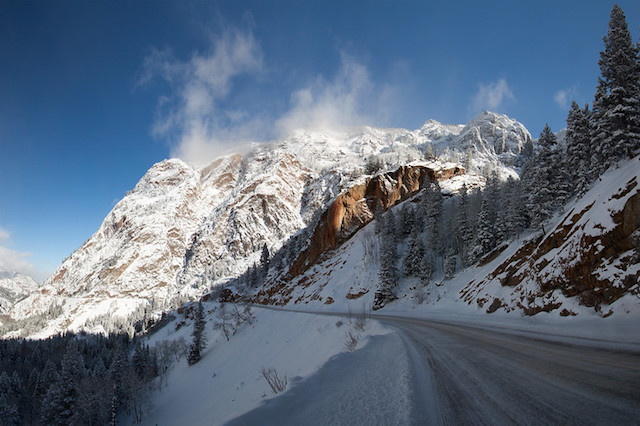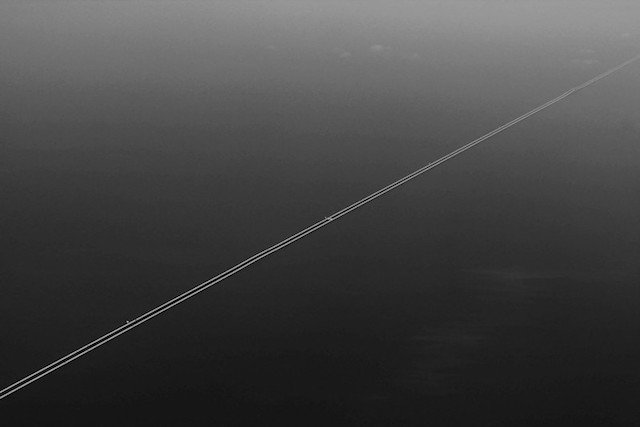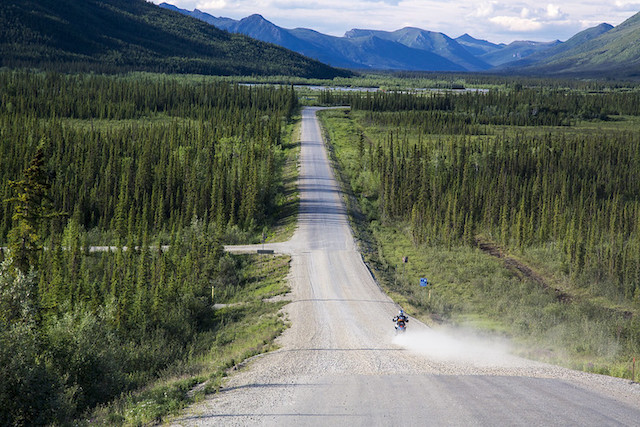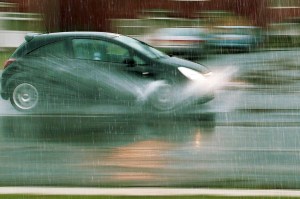It’s been said that danger lurks around every corner. This is never more true than on the road. Crashes can, and do, occur on any street, regardless of location, condition and speed limit. But not all roads are created equal. While some may have danger around the corner, others have danger all around. All this danger can make for some hair-raising drives.
Roads can be scary for a variety of reasons. Some travel through hazardous terrain, while others are so flat and straight they become breeding grounds for speeding and unsafe driving. You’ll find dangerous roads from coast to coast, in crowded metropolises and areas so remote they’re difficult to access.
Here’s a look at some of the scariest, nerve-racking roads in America.

Million Dollar Highway, Colorado
Officially known as U.S. Route 550, local legend says Colorado’s Million Dollar Highway got its moniker after an early traveler proclaimed she’d have to be paid $1 million to drive it again.
Winding through Red Mountain Pass in the San Juan Mountains, the roadway is undoubtedly one of the most breathtaking in the country. But those stunning views don’t come easily. You’ll encounter steep cliffs and hairpin turns as you climb the highway more than 11,000 feet above sea level. If that’s not unnerving enough, the road, carved into the side of the mountains, has no guardrails. Throw in some harsh Colorado weather and the occasional rock slide and you have one of the most dangerous roads in the country, according to a list compiled by USA Today.
U.S. Route 1, Florida
Florida doesn’t have Colorado’s mountains, but it does have another lurking danger: It’s one of roughly half the country’s states without a full ban on using a handheld cellphone while driving. That might help explain why a recent study found that 17 of the 100 deadliest roads in America were in the Sunshine State, the most in the country. The research, which looked at death totals from 2015 to 2019, found Florida’s section of U.S. 1 to be the country’s second deadliest road. In total, 87 people died there over that time.
Most of the route up the eastern coast is straight as an arrow, inviting drivers to reach dangerous speeds. The southern end, known as the Overseas Highway, connects the Florida Keys to Miami. It consists of miles and miles of bridge driving, something many people find distracting or unsettling.

Lake Pontchartrain Causeway, Louisiana
At nearly 24 miles long, the Lake Pontchartrain Causeway holds the Guinness World Record for longest bridge over water. Depending on how you feel about driving for a half-hour suspended over a lake, the causeway can be a thrilling or nerve-racking experience. When you get toward the middle of the bridge, where dry land is completely out of view, it will likely veer toward the latter.
Being surrounded by water also leaves drivers open to the elements: The causeway can become enveloped in fog so thick that police have to usher drivers across the lake.
I-4, Florida
Interstate 4 between Tampa and Daytona Beach was once found to be the deadliest interstate in the country, recording 1.41 fatalities per mile. One explanation for the road’s high incident rate could be its route directly through Orlando, one of the country’s premier tourist destinations. “What’s the first thing they do when they get off the plane?” Glenn Victor of the Florida Safety Council asked Fox 35 Orlando. “They rent a car that they’re not familiar with and they’re on their GPS, so they’re looking at the phone and their GPS which, of course, is a distraction while they’re driving.”
I-45, Texas
Some roads are innately dangerous because of how they were designed or the terrain they traverse. Others are dangerous simply because of how many drivers use them – and the number of ensuing crashes they cause. The congested Galveston to Dallas section of I-45, which runs through downtown Dallas, was recently named the deadliest road in America by Budget Direct. Citing heavy traffic and driver complacency, the company found I-45 averages 56.5 fatal accidents for every 100 miles of roadway.
I-10, Arizona
Interstate 10 spans the width of the country, stretching from Jacksonville, Fla., to Santa Monica, Calif., but it’s the roughly 300-mile stretch through Arizona that has proven most foreboding. The highway’s long, straight stretches through the desert are hot spots of high speeds, aggressive driving, illegal passing and inattentive drivers. Nearly 500 fatalities were recorded on Arizona’s I-10 over a recent six-year period.

I-15, Nevada and California
The 181-mile stretch of Interstate 15 connecting Las Vegas and Los Angeles is a straight, well-maintained roadway, conducive to safe traveling. And yet, it routinely ranks as one of the country’s most dangerous roads. One study looked at data over a 15-year span and found it to be the deadliest roadway in the country.
The problem isn’t the road – it’s the drivers. Motorists often speed on I-15 while traveling through the openness of the Mojave Desert. The fact they are likely coming or going from the party city of Las Vegas doesn’t help either. The same study found that nearly a quarter of the crashes occurring on that section of the I-15 involved a drunk driver.
I-285, Georgia
Atlanta’s I-285 is known as “The Perimeter” because it circles the city in a 64-mile loop. It connects all the area’s interstates and highways and, in doing so, welcomes an onslaught of traffic, including tractor-trailers. The combination of congestion, sharp turns, interchanges and large trucks has turned I-285 into a lethal stretch of pavement. In 2015, Vox calculated the road’s fatality rate at 3.5 per every 10 miles, which, at the time, made it the country’s deadliest interstate.
U.S. Route 17, South Carolina
Winding through forests, marshlands and oceanside towns, South Carolina’s Highway 17 is one of the most scenic drives in the southeast. But looks can be deceiving. The road is filled with an endless number of sharp, blind turns and narrow lanes. The area is also home as well as an abundance of wildlife, creating another potential driving hazard.
All told, U.S. 17 in South Carolina is one picturesque – but perilous – drive. In fact, one study named it the country’s most dangerous highway for summertime travel.

Dalton Highway, Alaska
The James Dalton Highway stretches 414 miles through the Alaskan wilderness from Fairbanks to Deadhorse, located on the shores of the Arctic Ocean. The dirt-and-gravel roadway was constructed in 1974 to help facilitate the oil industry and to this day is mostly used to transport oil.
The Dalton traverses through some of Alaska’s most treacherous terrain, including forests, tundras, steep grades and the Yukon River. Traveling along the road is so dramatic, in fact, it’s the focus of the hit television show “Ice Road Truckers.” But what makes the Dalton Highway particularly dangerous is its remoteness. There are only three towns along the entire route, which includes a 240-mile stretch without a single gas station or rest stop. Should something happen to you along the way, it may take a long time to get help.
Highway 2, Montana
Montana is the country’s fourth-largest state by size, but the eighth-smallest in population. This means you can drive for a quite some time before coming across anyone else. Open roads can lead to pleasant drives, but they can also be quite dangerous. Nowhere is this more true than on Montana’s Highway 2, which stretches east-west across the northern end of the state.
The roadway maintains a 70 mph speed limit, even as it winds through some mountainous regions. And while the scenic nature may be eye-popping, it also means you’re far away from the nearest help. In 2021, the median EMS call in Montana took a total of nearly 45 minutes. That number only gets higher when first responders have to travel to and from remote Highway 2.
Road to Hana, Hawaii
Driving around the islands of Hawaii seems like a journey through paradise, but be careful what you wish for, especially if you’re traveling along Maui’s Road to Hana.
The 52-mile road connects Kahului to Hana along the island’s rugged eastern shoreline. And though the highway offers picturesque views of mountaintops, lush greenery and crashing waves, the Road to Hana is far from a luxurious drive. Along the way, you’ll encounter a whopping 620 turns and 59 narrow bridges. The route requires such caution it takes motorists anywhere from two to four hours to complete. That’s why the Hawaii Tourism Authority recommends traveling with a permitted tour company instead.
Have you driven on any of these dangerous roads? Tell us in the comments below.
146 Thoughts on “Are These The Most Nerve-Racking Roads in America?”
Leave A Comment
Comments are subject to moderation and may or may not be published at the editor’s discretion. Only comments that are relevant to the article and add value to the Your AAA community will be considered. Comments may be edited for clarity and length.
















We are in Hawaii right now at a bed & breakfast off the Road to Hana. The B&B and it’s tropical environment and ocean views are beautiful and peaceful. However, my husband and I both agree that if you are weighing risk vs. reward, it’s not worth it to come here. The waterfalls on the road touted in the guidebooks often have “no parking” signs posted, so you’d have to violate the law to stop and see the waterfall. (There is one waterfall at a public park that does have parking on the road.) There are other beautiful places in Hawaii that have safer roads to get there. We are here in Maui shortly after the Lahaina fire which has reduced tourism down to almost nothing – even though we are 2-1/2 hours’ drive away from the disaster. The lack of traffic on the road has emboldened locals, who are driving too fast and not stopping across one-lane bridges at yield signs, even when our rental car is clearly already in the beginning of the bridge. To be fair to them, many one-lane bridges have yield signs that are a joke, because you can’t see the oncoming traffic with the severe curve in the road up ahead plus the heavy vegetation. I would never drive this road again. Driving the Road to Hana and not getting into a head-on collision on any one of its 61 one-lane bridges is sheer luck of the draw. We feel lucky to be unharmed. It’s not the relaxing vacation we envisioned. If you are going to drive the Road to Hana no matter what I say, drive it early on a Sunday morning when there will be little to no opposing traffic.
We live on hiway 128 in Mendocino county so we are used to windy roads.
Drove the road to Hana with my family many years past. Very beautiful and worth the drive. Don’t be in a hurry and give way to opposing drivers. Drove out Kahekili highway twice to watch the sunrise at the westen most point. Definitely a one lane road with no passing pullouts. Be real careful and drive a smaller car. One road that is quite exciting is the highway through Buller Gorge on the South Island NZ. One lane perched on girders on the side of a cliff above the Buller River. One curve under a rock overhang has a mirror do you can watch for opposing traffic. On the east side of the island you share one lane bridges across water ways with trains. Pay attention on the bridge approaches and take your time. A couple of them have curves on the bridge approach where a train can be hidden. Happy Trails.
I’ve driven over the Lake Pontchartrain causeway numerous times on my way to New Orleans from Texas. It’s the longest 30 or so minutes you’ll spend in a car. I’ve driven up to Pikes Peak in Colorado and several other high mountain roads in Colorado and none of those gave me anxiety like this endless bridge did.
Hwy 2 crossing Montana. One important fact that was left out was that until the mid-70s, there was no (I repeat NO) speed limit. The “official” understanding was that one should drive within the limits of safety in terms of traffic and road/weather conditions, and not having to worry about being stopped by Highway Patrol. This was the American version of the German Autobaun and it was not uncommon for cars to pass you doing 130+ MPH.
I have been on most of these roads more than once. The Million Dollar Highway is the most dangerous I have ever been on. I have crossed it three times, twice on a motorcycle and once in a vehicle. It is far more dangerous than the Tail of The Dragon in Tennessee and crossing into North Carolina. It has 318 curves in 11 miles. Neither is a road to drive unless you are a very skilled driver or motorcycle operator, and then you are still at the mercy of other drivers or riders. If you are a passenger while riding these two roads, you can enjoy the scenery. Operator cannot look away but for a second or two. The Bear tooth Mountain Passs from Red Lodge, Montana to Cooke City, Wyoming is also a challenge.
Fortunately, I live in Michigan where the roads are so bad that you can’t go too fast. If it’s not for the tremendous potholes that will destroy your vehicle, it’s the fact that there is so much road construction that you can’t actually get up to any decent speed. With all of the lane closures and detours you really spend most of your time trying to figure out how to get to where you’re going rather than actually driving.
Florida really has some of the most dangerous roads on pretty much every county, and the thought that they don’t have regulations on driving with no hand held phone laws make all the more dangerous. Beautiful state/beaches. That’s a pretty much cocky state overall, so be careful when driving there
It’s not the road that’s dangerous, it’s the driver. The article touched on it when mentioning FL I-4 and the Overseas highway. I have driven on the old version of the highway. It was built on top of a standard gauge railroad track so to say structurally it was dangerous would be true. See what happens when you limit yourself to a highway with no breakdown median.
After learning to drive in Florida, my parents moved up to Connecticut. In Fairfield County the roads, including I-95 were narrow and overcrowded until you were east of New London. However, it was the CT driver that was reckless and caused the accidents, not the driver. Note; this was before GPS.
Red Mountain Pass from Ouray to Silverton claimed the lives of my great grandfather and great aunt in the 1880s, and still is lethal in winter. However, I have driven the loop from Lake City up over Engineer Pass and back down Cinnamon Pass and found a retired couple in a rented Jeep CJ5, stopped in the middle of the road, crying because the drliver could not see how to navigate a tight spot in the road, at the 11,600 foot elevation. That road gives you a view of Ouray, where it leads on the West branch, and Red Mountain. Best to hire a driver on that one . Imogene Pass and Pearl Pass and Black Bear Pass over near Telluride are worse killers…flatlander beware!
The mMillion dollar highway going through the San Juans in Colorado is stunning. It would be dangerous to drive during a snowstorm. That aside, during good weather it’s a great road with incredible scenery. I would disagree with some of their comments regarding this road.
Highways in Montana are notoriously isolated. I think Highway two is so beautiful but absolutely it’s a lonely and desolate stretch, especially in the winter
In the 70’s before the new seven mile bridge in the Florida Keys was built I was driving west on the old bridge (US 1 Overseas Hwy) and had to stop to allow a car to pass before I turned left onto Pigeon Key. There was a slight curve on the bridge just before the exit onto the Key. My husband and I were rear ended by teenagers whom we had encountered in Marathon at a gas station bragging about the speed of their car. They immediately threw their beer over the bridge but it landed on the ground below ! And what good fortune that there was a Highway Patrolman who was exiting Pigeon Key at the time and was able to investigate. Several of us went to the hospital but no life threatening injuries, thank the Lord.
I am SO GLAD they have replaced the bridges in the Keys making them somewhat safer.
I-17 in Arizona. I dread taking that route when I want to
Travel from Phoenix to Flagstaff.
I totally agree about the 17
My Daughter died a year after an accident on I-15 close to Barstow California.
As a fairly new (3 year) resident of South Carolina I would put most roads here on that list for one reason. There are no shoulders to pull off on when driving on surface streets, which makes breaking down a recipe for disaster. You can be driving within the speed limit at a high rate of speed and come around a corner to encounter a line of stopped cars. The larger freeways do have shoulders, but add in the torrential rain, and it adds another degree of danger when you can’t see through the driving rain.
Schuylkill expressway. From the valley forge exit on the PA turnpike to Philadelphia
The “Sure Kill” Expressway ☠️. . Where the PA Turnpike ends and death begins.
The traffic there is so heavy it’s become more safe. I think US Rt 422 is taking over the distinction that the Schuylkill had!
I live just outside Orlando, and Ialways say I-4 is short for I-4Get-How-To-Drive. Not only is it crawling with tourists who don’t know where they’re going, but there always seems to be construction somewhere in the metro area. Recently, a ten-year project was completed, which included adding express toll lanes and rebuilding a number of exit ramps. While it was in progress, traffic patterns seemed to change on an almost weekly basis. The exit you took one day might be in a different spot or closed completely the next day. The combination of tourists unfamiliar with the area and confused locals trying to keep up with the changes were a recipe for disaster. And even now, residents are still getting acclimated to the new layour. Drivers abruptly cutting across two or more lanes are a regular occurrence. When you throw in the fact that most Floridians don’t seem to know what a turn signal is…yeah, it’s a miracle anyone ever gets off I-4 alive.
I live in Poinciana, and avoid I4 whenever I can. Eileen exactly described the problems, recently and currently.
The road to Hana didn’t seem so much dangerous as it was nauseating. The constant hairpin turns started to feel like a carnival ride, with accompanying nausea.
Totally agree, not sure how it can be deadly when the top speed you hit is about 15 mph. The smell of the flowers alone make the drive worth it though.
Sam, exactly my experience, too. Never made it to Hana. Turned around and headed back with stops along the way to settle waves of nausea.
I-10 in AZ is only dangerous because of the non-driving people who drive on it! It’s a basic interstate, but I have NEVER in 37yrs of life, seen such awful and clueless drivers! It often makes me wonder how many ppl on the road actually have things like brains or souls, and I swear, I am NOT being sarcastic! Zero intuition, zero consideration for others….it’s shockingly bad. After having to travel to AZ for a year for work, terrible drivers was in my top 5 reasons for not staying there permanently, and I’m from Chicago, where driving can be extremely intense. AZ beat us in the “bad driving” department by a LONG shot!
I drove on the Lake Ponchatrain bridge in 2003 in a tropical storm, this was before Katrina wiped the bridge out and it was considerably closer to the water.
I drove the road to Hana and loved it. I felt like Mario Andretti when I was done. A lot less scary than the road from Sedona to Jerome in Arizona.
I drive I-4 often, never had a problem. I’ve driven the road to Hana, loved it.
There are actually two roads to Hana. The back way is not even recognized as a road as the rental car companies do not want you to take it. It’s a narrow road hugging a cliff most of the way makes the other way (620 hairpin turns and 59 narrow bridges) to Hana look easy. There are several places when you look out the window and all you see is down.
I-10 is nuts because several times I have seen what appeared to be illegal immigrants drive very erratically. Once I had a guy in front of me in the left lane, slam on his breaks (smoking tires) and pull into the median and make a u-turn.
I-285 – Atlanta’s racetrack. Always nerve-racking because of the sheer volume of traffic doing 80+mph.
I miss the Garden State Parkway.
I-4 is like driving Route 22
You left out the Pasadena Freeway which connects Pasadena, CA and downtown Los Angeles. Oldest freeway in the LA system with twists and turns that challenge the most experienced LA driver. Plus onramps with stop signs which necessitate entering a freeway lane from a standing stop.
All but Hana, never driven in Hawaii
Years ago, Route 2 in Maine between Houlton and Bangor would have been on this list. It was so bad, an old country singer wrote a sone about it called “Tombstone Every Mile”.
I’ve done 7 of the 12.
Million Dollar Highway sounds great! Must do someday!
Route 1 & I-4 in Florida. No big deal, IMO.
Lake Pontchartrain is interesting! It gets weird after about halfway!
I-10 in AZ & I-15 in NV are just boring!
I-285 around Atlanta is a speedway! Do more than 80, or you get run over!
The Road to Hana is outstanding! We had a Mustang convertible for our trip, and loved it!
I live in Arizona, and I love visiting southwest Colorado where US 550 is located, but only in summer months. On 550 between Ouray and Silverton, the beauty is breathtaking, but if you are driving, keep your eyes on the road. I live in Sedona, AZ, and there is a 2 mile stretch of Highway 89A that has been listed in the top 10 most dangerous roads in Arizona. This part of 89A traverses a portion of Sedona we locals call West Sedona. The road is 5 lanes wide with center left hand turning lane and bike lanes on either side. Speed is 35 mph. Mostly a shopping district. Mostly level with 1 gentle curve. Sounds okay on paper but it isn’t. Four things make it not so. 1. Sedona is a popular tourist destination with lots of traffic during the day, combined with drivers not familiar with the area. 2. Large group of elderly retirees with some who should not be driving (numerous traffic incidents). 3. In a 2 mile stretch there 180 turnouts (driveways and streets). 4. And, of course, everyone is driving above the speed limit. One accident had a car upside down in the middle of an intersection. We have even had 2 planes crash on the same stretch of road (one nearly missing a gas station by about 2 ft.).
I’ve been on parts of many of those roads, but the scariest I’ve seen was I70 in western Kansas in a 1967 VW bug with strong crosswinds takes the cake, especially when passing or being passed by a truck!
Million Dollar Highway is beautiful no matter the time of year. Definitely need winter tires for safety. High mountain passes in Colorado get hairy in general. I would have to say I-45 is my least favorite road though. Coming from the woodlands north of Houston, all the way to Galveston. I’ve seen several crashes happen right in front of me going to Galveston. I would much rather deal with snowy roads.
The Chesapeake Bay Bridge Tunnel (US 13) is my nightmare road. In a storm, or twilight, you go bridge, tunnel, bridge, tunnel — it’s hard to refocus your eyes. You also feel like you are just above the water height — it’s terrifying.
Montana 191 is a death trap between four corners and west Yellowstone due to poor driving tourists, temp workers from the south and elk strikes. 360 carcasses this year alone.
I’ve driven the Hana Highway 3 times. It’s a challenge although the scenery along the way is beautiful. I was constantly turning for 4 hours.
California State Route 41 between Paso Robles and the SR 41/46 junction at Cholame can be dangerous. Passing multiple vehicles at one time leads to many collisions. Also, factor in the impaired drivers from the Lemoore casino.
My Daughter was 13 when she first heard me utter the “F” word. Naturally, we were on the Road to Hana when one idiot too many decided they were crossing that one lane bridge no matter who was already on it. I tried everything I could to stop it but once F… started tumbling out there was nothing could do. After several seconds of total silence, I apologized to my Wife and Daughter for what I said, to which my Daughter replied “Dad, I go to public school.”
I-15 is definitely dangerous. You always see crashes and it is pretty routine to get caught in the backup of a crash leaving from Vegas back to So Cal.
You really have to pay attention.
The George Washington or (fka Tappan Zee) Mario Cuomo Bridge, both over the Hudson River in any wind is downright treacherous in a light or heavy vehicle
I was a driver for a large grocery chain. You can go 85 south or north through the center of Atlanta and stay off I285. Also if you need to go through Atlanta go very early in the morning or after 9am or before 3pm. You can also go up hwy 29 all the way to South Carolina. In addition, a road atlas or map is useful if you can read one. GPS is useful but it is a tool not the final answer. I carried a laptop with wifi to plan my trip. Also common sense is useful if you have any. Plan your trip don’t just start driving. I’ve got more than a million miles driving experience. Don’t use phone and pay attention.
John
So many roads not counted.
– The California coast leading up towards Oregon – people have literally died
– Siskiyou Pass (N. California –> Southern Oregon) – doing it at night when it’s snowing is extremely problematic
– Western Washington, I believe it’s 520, the bridge that goes over the water. That actually DID collapse in the past and you can feel it swaying in the high winds
– The junction between N. California/S. Oregon and NW. Nevada, if you rely on Google Nav, it will send you down an unpaved road, I’m talking ROCKS, not dirt, complete with gates that look forced open, through a forest, and at one point you’re literally hairpinning down the side of a mountain until you get to a perfectly paved road in Nevada. You talk about gripping.
Driving at night in a snowstorm..Isn’t that every road in the world ??
I’ve driven seven of the highways and bi-ways mentioned. The author is on track on all the highways I’ve driven. I’ll describe my adventures as follows:
1971 — Hwy. 2– If the roads don’t get you, the lightning will. I nearly exploded when the lightning struck my 56’ Chevy during a lightning storm.
1972 — Colorado’s million dollar mistake: Two college kids drove this road in February. No snow tires in Ford Fairlane. We could have slid right off the mountain!
1980-1993
I-285 encircling Atlanta was never a problem, except when downpours poured water.
I-4 at rush hour was downright miserable for reasons stated.
US Route 1 in Florida and US Route 17 in SC get to meandering awards!
1994 – Road to Hana
There’s nothing like getting up at 2:30am to head to Haliakilea. And then riding a mountain bike down as temps rose from 32 to 80 degrees.
That not the road to Hana
The Road to Hana, hands down is the most dangerous road I’ve ever been on. Maybe it didn’t help that I wasn’t behind the wheel, and I was bare knuckling it all the way, because I was uncomfortable with the driver. It took us all afternoon to get there. Once you get to Hana, the road ahead is not paved. If we had gone back the way we came, we would have been doing it at night and driving on the ocean side. One false move, and we would have been going down the cliff. I was in charge of the map. Even though, technically, we were supposed to keep our rental on paved road, I told the driver to keep going on the dirt road. The scenery was unbelievable. It was tough going in the beginning, but we didn’t hit any major problems. More importantly, there was no cliff or ocean on either side of the road. Eventually, we hit pavement, and I started to breathe again.
I have to agree with you on all factors.
Lake Ponchartrain Causeway, LOVE IT. Drive it roundtrip from New Orleans to Natchez, MS when I travel south. It never disappoints. I actually find driving over the water calming. Even in rain or when the wind induces waves.
In Greece at the end of a long hot dry season I was driving down a well blacktopped curvy mountain road with a serious drop on the upside. Nice wide lanes. Very little traffic. I knew I was driving slow enough that I could take the curves with no or a light touch of the brake. For the first in months of no rain, it started raining. I was happy with the thought that the rain would be cooling things off, blissfully unaware of the reaction of the rain with the blistering hot blacktop. Suddenly a curve requiring of me a bit more breaking than usual. But, alas, just enough braking to cause my car to uncontrollably slide over the “black ice” slippery road to ineluctably go over the the edge. But my luck (or “eluct” ) held—ponderously coming up the outter lane was a gargantuan black Mercedes that crashed into my car, stopping it from a perilous fall (there were no guardrails, albeit there was sufficient space between the edge of the blacktop & the perilous fall). This is off topic, but maybe serves to point out how a good road can be turned lethal in unexpected ways by a seemingly innocent weather event.
Having driven in all 48 contiguous states, I have found there are dangerous roads (including these) in every state. As several have commented on here, many times the road itself is not the danger, the danger is the drivers you encounter on those roads. Whether it be drunk divers, seniors with difficulty driving at night, or distracted drivers looking at scenic views or their cell phones, etc., if you stay alert and watch out for other drivers, you are much less likely to become a statistic. Also, to avoid becoming one of those drivers yourself, pull off the road to enjoy those incredible views you see on some roads. Along with the Lake Pontchartrain Causeway, the most unnerving site to me are the emergency truck pull outs found on many roads in the mountainous areas of the West. Built as uphill emergency pull outs with a base of soft soil or sand, they are meant for truckers who might lose their brakes on the steep downhills. That thought always has me looking in my rear view mirrors whenever I am in mountain country.’
I vote for the Pennsylvania Turnpike, especially the sections near Breezewood, I80 is a better alternative, NYC to PGH. Rain or sleet/snow, two lanes twisting about and tractor/trailers occupying both lanes. Enough already! And the Cross Bronx, if you can get above a couple of miles per hour, your cruisin’! Slow speeds on the CBE make for less deadly accidents.
Yeah, the PA Turnpike is nasty–far too narrow, and people drive way faster than they should. But I-80 is a deathtrap, especially during the winter. Every year there is at least one multi-fatality, multi-vehicle pile up, usually due to idiots not knowing to slow down during foggy or whiteout conditions. I take Rt. 22 when traveling from Harrisburg through Altoona and on to Pittsburgh, and vice versa.
The Causeway over Lake Pontchartrain might be the scariest I have ever taken, and I have driven in Africa, Central America, and other challenging places. There are no shoulders to pull over onto, and you look straight down at the water. I kept thinking “Alligators are down there waiting for me if I do anything wrong”
We have driven several of these roads over a period of 35 years. The roads are not the danger but the incompetence of the drivers are. Every road has a caution level for different reasons that must be respected. Only roads that are not properly maintained should be considered dangerous. Better drivers equals better safety !
Let’s admit the real reason there are so many dangerous roads in FLA; it’s God’s waiting room. The huge number of seniors living there are the real reason. Not all are bad drivers and most weren’t always bad drivers but many have trouble admitting when it’s time to hang up the keys.
My mother lived in North Port on the west coast and it was common knowledge that if you drove on Route 41 at night you were probably going to experience an elderly driving coming right at you in your lane. 41 was two lanes north and two south divided by a grass median strip. Elderly drivers got confused pulled out of side streets in the dark and instead of going far enough to cross the median to go north or south they just turned onto the road….going south in the northbound lane or vice versa. It happened to me while visiting my mom numerous times. Luckily I was watching for it and avoided a collision. Some of my mom’s friends weren’t so lucky.
There are lots of mountain roads here in Idaho without guardrails, so that doesn’t bother me. I can always spot drivers from the flatlands, they hug the centerline and drive at a crawl on mountain roads.
I’ve driven all over the country, including a road trip to the Florida Keys from Washington state and the PCH from end to end.
The worst drivers are on Long Island, hands down. My parents live in Suffolk County and the drivers are nuts.
O yes! Pacific Coast Highway 1 while we were driving in the outer lane above the cliffs, another driver on the inner lane, removed his hands from the steering wheel to video the scenery! Duh! My husband is from Italy. We had to drive the narrow roads in the mountains above the coastline above the Riviera to get to and from his brother’s home. Many times, while we were in the outer lane, as we came down and around the numerous precarious curves, we would be met by the local bus coming up in the opposite direction. We would have to quickly make room for it, but only God know how! Our nephew said that many a car winds up on top of the olive trees in the groves below.
I’d like to see another article on the 10 deadliest American highways to drive at night, specifically because of the headlights of oncoming traffic. And please address the brighter bulbs in headlights these days, and how they are affecting drivers. In the “old days”, I can’t recall as many people complaining about night vision driving as the do today, and I believe it’s due to these headlights. I think they should be banned!!!
Totally agree about those crazy headlights- I can’t understand how they are even allowed. Great for the driver of that car, deadly for everone else!
I-10 in AZ is dangerous not just because of high speeds, glaring sun, and mind-numbing monotony, but the dust storms come up suddenly causing zero visibility. I’ve driven from Miami to Key West with white knuckles in bad storms, with crazies passing cars on 2-lane sections where they can’t see what’s coming. A friend was killed in a head on collision on that section of HWY 1 so I’ll never drive it again. And I-95 around NYC should definitely make the list, for all the reasons given by other commenters and the hubcap it swallowed from my Toyota.
I-95 in the Bronx is probably the safest roadway in the world because we can only go 1 mile per hour on it!
Agreed! I think that 1 mph might be a little high on the Cross Bronx Distressway!
You are so right. 95 in Providence, Rhode Island, is getting just as bad. Somehow there are still tons of accidents, though.
The I-95 stretch you mentioned is a living nightmare. I avoid it at any cost. A speeding ticket would be a badge of honor (:0)
Seriously, stay away!!!!
My wife and I took vacations in Ireland and in Italy. The roads in both beautiful countries can give all those U.S. roads a run for their money. Narrow, hairpin turns, and bicyclists with a death wish sharing what little road there is with the speeding cars. Still — and this comment applies to all the mentioned roads — we all made it back alive, didn’t we.
Going through Atlanta you have 2 choices:
Go through downtown using the Downtown Connector where I75 and I85 converge. Don’t try to play it safe in the right lane as it will probably turn into an ‘exit only’ lane. The two interstates split; but take care – I 75 continues to the Western suburbs but you must take the split on the Right and I 85 continues to the Eastern suburbs but you take the split on the left.. You can take the ring road to avoid downtown but all trucks must take tgst road and it’s crowded and the drivers go fast…Good thing is, Atlanta drivers have good reflexes.
Yes, I experienced going through Atlanta trying to get to the Airport–the activity which brought me to Atlanta was on the opposite side of the Metropolitan Area from the Airport, and there had been a rainstorm just before I tried to return to the Airport. A number of underpasses were flooded! I have good directional instincts, and can navigate New York City and boroughs with ease, but this flummoxed me! This was before phones had GPS, so I called my husband and had him navigate me using Google Maps. I got to the Airport with 0 time to spare, but fortunately, due to the rainstorm, the departure was delayed, and I made the flight
Your research is interesting. I-45 from Galveston to Dallas made the list. The writer stated it goes through downtown Dallas but omitted that it also goes directly through downtown Houston (Harris Co.), the 4th largest city in the USA.
The original source article (Budget Direct’s list of most dangerous roads by country) declared it the most deadly in the USA:
“The most deadly road in the United States is Interstate 45, running north from Galveston to Dallas through Houston, Texas. This road has seen 56.5 fatal accidents for every 100 miles of roadway, thanks to a combination of busy, urban stretches and driver complacency. Harris County is currently suing the Texas transportation department to prevent a planned expansion of the deadly road.”
Glad you caught that point. Yes driving from Galveston, where I grew up, and having to drive thru Houston has always been a challenge. I-45 has been under constant construction FOREVER. As long as I can remember, I’m now 66, there has been construction there FOREVER… And you add that half of Houston go there on the summer weekends, I-45 is more then a nightmare. 2 years ago a very determined driver that I’m sure was more then high on something, had 3′ swords, yes swords like in Roman days, stuck out from his rims and spinning as he drove down the interstate. Needless to say his plan seemed to work he was clearing traffic for himself………..
The primary reason why Hwy 2 in Montana, and specifically the stretch through the Yak River valley is so dangerous isn’t speed, it’s deer and elk crossing the highway. There are many blind turns, as well as being buried in forests, leading to minimal light and virtually no sight distance. Montana’s highways department also has the charming practice of placing crosses made from T posts at the site of a traffic fatality. That section of Hwy 2 is littered with them
I took the road to Hana expecting a chilling adventure of a drive and while beautiful it was no more challenging than driving the Pacific Coast Highway 1 through N.California’s Sonoma, Mendocino, Humboldt and Del Norte counties. That’s a challenge! In addition to the constant blind curves, sheer drops, switch backs, and cyclists, you have elk, deer, sheep and cows on the road to worry about too. Occasionally pieces of the road fall into the ocean! That’s a thrill ride with with no rails!
The Bear Tooth Pass in Wyoming/Montana is not for the faint of heart! Located near Yellowstone between Red Lodge and Wyoming state line. Approx 11000 ft above sea level, hairpin turns, not open May thru Oct… I know it’s bad when my husband moans as he’s going around a turn, as I have misread the map not knowing how high up we are going, trying to reassure him just another 10 minutes! Lol! I cried when we got to the motel in Red lodge… terrifying, had snow and ice up there in August. Note to self: read elevation correctly on maps!
Rt. 81 in SW Virginia gets my vote. The truckers take over both lanes, speed, tailgate, and cause accidents galore. The locals know to avoid it if at all possible.
https://www.wdbj7.com/content/news/I-81–566354041.html
https://wset.com/news/local/vdot-i-81-is-one-of-the-most-dangerous-interstates-projects-will-begin-to-improve-safety
https://www.fishwickandassociates.com/blog/2021/05/using-interstate-81-increases-the-odds-of-truck-crash-involvement/
Yes and the trucks are always passing each other going about 80 mph while i am in the middle lane with white knuckles wishing trucks had a special lane for themselves.
I81 in SW VA also wins my vote. I live in Salem,VA and avoid it at all costs. Only two lanes of traffic for crazy numbers of trucks and cars and people tailgate and drive over the 70 mph speed limit. It’s a death trap with daily accidents and fatalities.
I-81 in SW Va is a death trap. Over 2,000 tractor trailer accidents every year. People speed and tailgate and there’s only 2 lanes for all that traffic!
I drove the Road to Hana 2 times back in the 70″s. An amazing drive, agreed not for fearful drivers. My friend and I choose to follow the unpaved section instead of turning around. Best choice of the trip. Some magnificent secenry and we got to meet a Hawaiian cattle rancher, who was friendly and proved to be a good ambassador for the state and provided a meal better than any restaurant. Would do it all again in a heartbeat.
We drove the road to Hana many years ago. It’s a wonderful and well worth experience. Don’t attempt it if you don’t like to drive. It does require concentration.
However we are New Yorker’s and drive the Saw Mill River Parkway, the Bronx River Parkway and the Jackie Robinson Parkway which are far more trecherous and dangerous.
Try averaging 68 MPH up the MT Washington Auto toll road.
I did the Road to Hana years ago with two (2) other friends in a rental car. My friend who was driving was a terrible driver, but she put her name on the rental agreement before the rest of us go to the desk, so she was the only one to drive. We started about noon, and got to Hana about 6:00. The scenery was beautiful but nerve wracking, with hair pin turns all the way. By the time we got to Hana, the sun was going down. If we had turned around, we would have been driving on the cliff side, with a terrible driver, at night. The other choice was to keep going, which would carry us over the unpaved road. Since I had the map, I chose the unpaved road. The scenery was surreal, but I actually felt safer. We eventually hit pavement, and I started to breathe. I’m glad for the experience, but I’ll never do it again.
How can California Highway between Carmel and Big Sur, and probably south of that too. No guardrails where road hangs over the ocean, and solid rock cliffs down to the edge of the highway. Also California drivers whizzing past me as I observed the posted speed limit. Definitely not for the faint-heartrd.
Why are dangerous roads allowed to be used by the public? This is unbelievable in the 21st Century!
I’ve driven 5 of roads listed. By far, the most dangerous to me is I-15 between Vegas and LA. Speed plays a big part in making it so dangerous plus the California drivers never wanting to get in line to pass a slower moving vehicle. They will pass you on the right and cut in over and over. Thus your slamming on your brakes constantly because they will cut you off. Never drive it on a weekend or the eve of a holiday, bumper to bumper traffic for 200 miles is no picnic.
How about those crazy, winding mountain roads in West Virginia? On one side you’re looking over the side of a mountain, often with no guard rail, and on the other you see a deep ditch that would wreck you car immediately beside a steep rock face with no escape. It’s just living with the terrain that exists, but intense adaptation is required in order to survive!
I just got back from North Carolina and took a ride on the Blue Ridge Parkway. Great views but very scary. We were driving along and the traffic stopped for 15 minutes. When we finally got going again we passed an ambulance, a fire truck, and several men wearing climbing gear. There was a woman sitting on the side of the road and looked like she was in shock. We never did hear what happen but it must have been awful. I won’t be driving that road again.
US-14 near Sheridan Wyoming has my vote. I would not want tp drive it with a trailer!
Most dangerous highway? US Route 22 between GardenStatePkwy and MountainsideNJ. Most of it is 3lanes each way. Worst part is when road divides and there are many stores in the middle. Picture drivers exiting median store parking lots (or U-turns) into the left lane (with drivers already in the left lane doing 50-60mph or more!). Not to mention folks driving at those speeds close to bumper-to-bumper!
#2? The TaconicStateParkway (NY) at night. Folks doing 60-70mph with almost no streetlights, very short entrance/exit ramps, and very little visibility due to lots of vegetation close to the road.
Storrow Dr is bad enough but Jamaicaway has smaller lanes, more and tighter curves to add to the excitement. If you don’t go fast enough someone will be right on your bumper.
Clearly no one has been to NY and NJ. Potholes deep 1 to 4 feet aren’t considered dangerous? damaging vehicles daily. potholes at every corner.
This article is invalid without the stretch of US-22 in Union, NJ (and Morris Ave., NJ-82, also in Union).
I agree with the Rt-22 Union, especially during holiday shopping time when people don’t know where the store they are looking for is located so the dart between the island stores in the middle, the outer edge stores to the right and the endless u-turns whhich you can use to get the the extreme left hand side stores or to loop around again if you mess-up – within 3 lanes of speeding traffic each way!
Article should have included “The Dragon” in North Carolina and the “old” Alligator Alley”, South Florida
Definitely both of these!
I live on Maui. The road to Hana is a cakewalk compared to the alternative road back from Hana that snakes along Maui’s south shore. Single lane in places, often blocked by landslides and floods, the virtually unmaintained road is carved into sheer cliffs and is a mashup of dirt and ancient potholed blacktop. The views, however, put those of the conventional road to shame. A far tougher road, IMHO is the Kahehili Hwy along Maui’s north shore. Mostly single lane with sheer cliffs and blind curves. Backing up a steep cliff-side incline with no guard rails to accommodate an impatient local going in the opposite direction is not for the faint of heart. The newspaper has occasional reports of fatalities associated with cars that went off the edge. Stick to the beaches.
My dearest friend lives in Kihei, and we do Hana every time I come visit. So I’ve been doing it for roughly 9-10 years now, and while it can be unsettling, so long as you rent a smaller car, go slow, and take some Dramamine, it’s one of the most magical experiences. Is it a tad unsettling? Sure, but Ive never been terrified or white knuckling through the experience. I think there’s a misnomer in it being called “The Road to Hana” because people think there’s something in Hana that is the point of the endeavor, while the scenery and incredible hiking along the way is the point. I havent been back to Maui since the pandemic, but my friend said the road has been a complete nightmare since the influx of travelers. Imagine those hair pin turns only to immediately find yourself in the face of a parking lot of cars having parked haphazardly all along the sides of the road (that does NOT have room for a ton of cars!). Nightmare. I wonder if you’ve seen this over the last two years? I’ve also always been shocked people turn around at Hana. I go start at Paiea and once I hit Hana, I go through, coming out through Up Country and back down to Kihei. The backside is even more stunning, IMO! Lastly, your comment on Kahehili Hwy is so accurate. I was so scared the first 10 minutes I just turned around (I was terrified in turning around because it was a near impossible feat). I havent EVER felt that way when on the Road to Hana!
The entire length of I95 both ways from the RI border through CT and into NY to the George Washington Bridge has got to be an honorable mention. The road is in bad shape, under construction of some sorts in several locations often at the same time, not to mention constant horrible traffic that barely moves anytime of the day or night, often with accidents in both directions of various degrees. Forget Fridays in the Summer it’s even worse; and with year round west bound sun glare in the late afternoon/evenings it’s a nightmare with unfortunately few easy alternatives to avoid any of this in either direction.
Here’s the trouble with the road to Hana. We were told how dangerous it is and that when the paved section (which provided magnificent views) ended, we should turn around. I don’t remember seeing the warning while driving that the paved section was ending and the dirt road was beginning. We came upon the unpaved section so suddenly that we decided to do a U-turn at the first opportunity. That opportunity never arrived. There were no turn-offs or side roads or driveways and the road was too narrow to do a U-turn. We crawled along and along the roadside was grass so tall you could not see around any bends. We did come across one van coming in the opposite direction and getting past was like conducting a military operation. We must have driven for more than an hour and eventually saw a small village (Hana?) in the valley below where we turned around. Driving back, we were terrified because if we had met a car coming towards us, we would have had to maneuvre on the steep downslope side of the road. So I drove fast to reduce the time that an oncoming vehicle may have been on the road. There were none. Next time we drive on this road, we’re packing parachutes just in case.
What about the Cross Bronx Expressway? I mistakenly got on it last Friday afternoon around 5 PM and the GPS lady came on and said, “The Cross Bronx? Really? At this time of day?
that’s hilarious!
Thought I’d see something in Massachusetts, Boston in particular. How about the Jamaicaway or Storrow Drive?
WARNING!!! The Jacky Robinson Pkwy E (formerly the Interboro Pkwy) has many narrow turns and a kink in it as it travels under Queens Blvd. West to east is the worst direction. Suggestion-try not to travel along side another vehicle.
It was much worse 50 years ago, when the curves were sharper and the lanes were narrower. (They couldn’t improve the section you mentioned.)
How about the Taconic State Parkway? Narrow lanes, curves, stone walls, crazy drivers.
The Taconic! A friend told me to never drive in the left lane. At about 1-2 AM he was driving north in the right lane and saw a car heading south towards him in the north bound left lane! The driver got confused getting onto the Taconic and perhaps alcohol was involved.
US Route 1, Florida, “Overseas Highway from Key West to Miami
Been there, done that, can’t wait to do it again.
I-10, Arizona
Been there, done that, not planning to do it again. Rt. 66 yes, I-10, not so much.
Lake Pontchartrain Causeway, Louisiana
Now on the list, can’t wait!
I for sure thought I’d find at least one road from NY on here. People drive on the Long Island Expressway (495) and southern state parkway like it’s the Autobahn!
Road to Hana was definitely at the bottom of my favorite memories of Maui. Carsick the entire time! Fellow travelers who had traveled “the Road” before, said “never again”.
Road to Hana is a true white-knuckle ride! It was very adventuresome but not for the faint of heart. Best to go from Kahului to Kaupo as you’ll be on the inside rather than the outside, unless you’re completely fearless!
My husband and I travelled the road to Hana in 1986. He really enjoyed the drive because I was so frightened I couldn’t speak all the way there or all the way back.
US1 in Florida, or in any other state, is a federal highway, not an interstate. Yes, it goes from Maine to Florida, through all those states, but it’s not part of the Interstate Highway System.
Using cell phones and distracted driving are only parts of the story with that road. It goes through open areas, very congested shopping areas, residential areas and seemingly never-ending construction. It changes from a two-lane highway to six or more lanes in some areas and has lots of traffic lights.
Have you looked at the Jackie Robinson Parkway, formerly known as the Interboro Parkway?
Yes, definitely. One of the scariest roads I’ve ever driven on.
I did the road to Hana in 2017 with a guided bus tour. I felt very safe. However experiencing it I knew I’d never do it alone
I traveled I-10 in Arizona , Rte 1 in Florida. Parts of I-17. I-95 New York to Florida.
I did the road to Hana in 2017 with a guided bus tour. I felt very safe. However experiencing it I knew I’d never do it alone
I traveled I-10 in Arizon. Rte 1 in Florida. Parts of I-17. I-95 New York to Florida.
The BQE is getting a revamp, and the relatively new Kosciuszko Bridge is beautiful and safer.
Granted the new Kosciusko bridge is a beautiful and is an big improvement for that section of the BQE. However that is largely negated by the start of the project to rebuild the cantilevered multi deck portion under the Brooklyn Esplanade. As a stop gap measure to forestall collapse, lanes in that section will be reduced to two ausing massive delays. Estimated time for completion of the replacement of this cantilevered section of the BQE is 10 years.
I just remembered…There is a road in Spain that takes you to top of Ronda, where house hang 5,000 feet over the edge of cliffs. We took a bus there, andit was so close to the edge that when you looked over the cliff, you saw wrecked cars at the bottom.
I drove that road at night while it was under reconstruction. I had no idea how dangerous it was until I got back to my hotel and described my trip to the concierge. He was quite amazed I made it back alive.
I so agree Barbara. The road to Ronda was the scariest road I have ever been on-my husband drove and my heart was in my throat the whole time! When we went to Maui to the road to Hana, I was pleasantly surprised-nothing compared to Ronda! Also the ride to the rock of Gibraltar was harrowing too!
I drove the road to Ronda in a tiny Siat 500 many years ago. A thrill a minute, but worth it!
The bridge across Lake Pontchartrain was mesmerizing, like the Miami to Key West, but I never felt unnerved until I drove to the top of Pike’s Peak!
Not one mention of New York City roads? The Brooklyn Queens Expressway (Interstate 278). It is challenging and nerve wracking going from ground level to elevated and back, winding around buildings, a major truck route, no shoulders, sudden on and off ramps, lanes that disappear without warning, and innumerable potholes. To use a phrase from a song that applies: “There’s a tombstone every mile”
You forgot to mention Highway I 95. On the road between New Haven and new York city there is seldom a trip when there is not an accident
We have driven I-4 between Tampa, FL and Dayton Beach through Orlando/Kissimmee many times and we found that distracted drivers not paying attention to driving to be the worst problem. Glad we don’t live in Tampa Bay Area any longer.
I worked I-95 for 30 yrs in the east, how could you not list this road?
Skip the Road to Hana altogether, even WITH a tour company. We did it with a small tour bus and the experience can be described as 4 hours of heart-in-your-throat anxiety with absolutely NOTHING too see when you get to Hana….. And then do it all over again on the ride back!
We took that ride 35 years ago on our honeymoon. I could not have described the experience any better. LOL
so true! very disappointed after driving very slowly to get to Hana. Hawaii should pave the southern route also. Might be quicker way to get back . Had a rental car, so didn’t want to chance going on unpaved roads. Would never recommend it to anyone.
It took me 4 hours to drive the Hana Highway on Maui. To do so I had to take a Dramamine to control my nausea (and it worked) in both directions. I think the fact that I was driving on a curve and my eye could see the curves coming up added to me feeling nauseous. It was incredibly beautiful and something I will never forget.
My wife & I drove Maui’s Road to Hana a few years ago, going roughly north to south. When we ran out of paved road after Ke‘Anae, we asked a local at his mailbox if it was safe and/or sensible to drive the rest of the road around the southeast part of the island, and whether our rental car could be damaged or put out of commission by the road. He said to drive slowly and watch for potential hazards. We did, and the scenery was beautiful. (The northern, paved part of the road, through Ke‘Anae, may have been more dangerous than the southern, unpaved part, because of the many cars traveling in both directions. All hairpin curves must be taken VERY slowly, because you can’t see far enough to know what you’ll encounter!)
We did the Road to Hana. Beautiful but never again!!
I drove the Hana Road at night, after our flight was delayed. It was actually better at night since I could see headlights coming around corners. Still a wild – and beautiful – ride!
Ditto!!! Those hairpin turns were sacary as all hell!!! No doubt, the mountain views and visiting/swimming @ the Seven Falls of Hana, was memorable, but will never take the road to Hana again!
Please do an article about Nassau County having 3rd highest auto fatalities in nation, ahnd Suffolk County having highest fatalies.
Of course. The Southern State Parkway has to be among the worst. The most aggressive, inconsiderate, dangerous drivers imaginable.
What about the Taconic State Parkway?Especially at night!
It had been a long time since we had driven to Florida and I was astounded by the way people drive. Coming back, on I 95, through Virginia up until the Mass line was some of the most dangerous driving I have ever experienced. I have done driving in my life from the east coast, west coast, north and south, all over the country and we had so many near misses on this stretch of I 95, that I lost count. All I could think was that these people have a death wish!!! No one ever should say a word about Massachusetts drivers again!!!
I was fully expecting the Taconic to be on this list and was very surprised it wasn’t. Once, in the dark in winter we were driving south, in the right lane, and suddenly, coming TOWARD us in the left lane was someone going north doing about 95. Terrifying.
To be clear, because I realize I wasn’t, the car going north was going in the wrong direction in the south lanes.
Yup! And the Saw Mill River Parkway!
My hubby and I and two friends drove the million dollar highway in 2001. We made my hubby drive because the rest of us were too scared to drive it! No guardrails was frightening. He did a great job, though, driving it. Beautiful scenery all around, but you don’t dare move your eyes off the road to view it, for too long.
I don’t remember ever being more scared driving than the part of that road out of Oure until Silverton. Light snow (1st week of May 1996), wet road, far too many RVs headed the other way. I pretty much had to pry my hands from the steering wheel when I completed it. Never again will I drive it that direction which puts you on the outside, no-guardrail lane!
You got the reason why the ‘million dollar highway’ in Colorado got its name wrong. The road base gravel for this road was crshed from local mine tailings, and it is said that there is at least a million dollars worth of gold and silver in every mile of that gravel. And that comment was made when the price f gold was less than $40/ounce ! If you want to get an higher pucker factor than any of these roads provide–try either the ‘Oh My God’ road between Central City and Idaho Springs, Colorado, or the Imogene Pass road between Ouray and Telluride, or the Royal Flush road which takes you to the top of hahn’s Peak near Hahn’s Peak, Colorado.